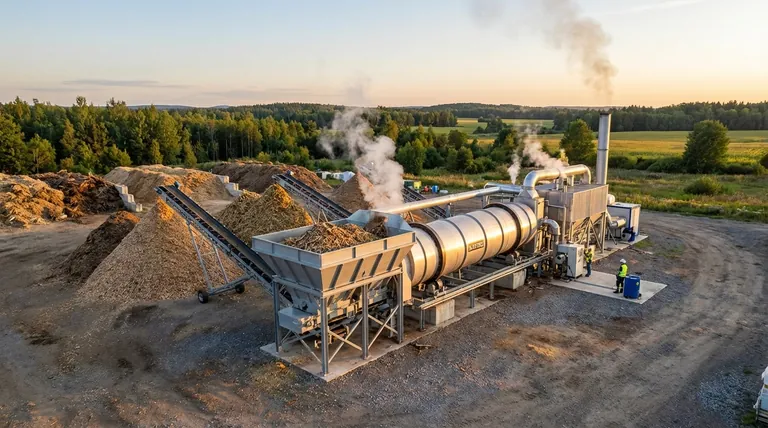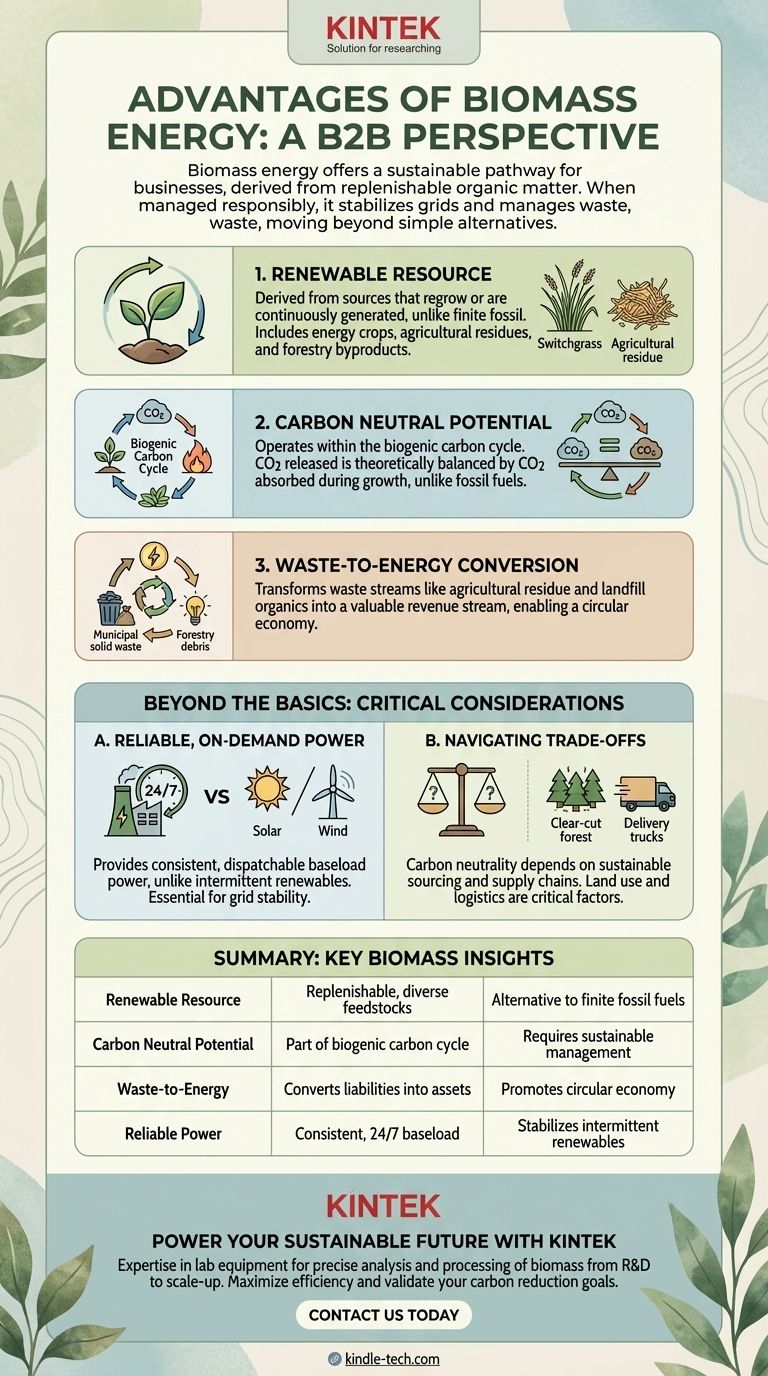The three primary advantages of biomass energy are its renewable nature, its potential for carbon neutrality, and its ability to convert waste into fuel. Biomass is derived from organic matter like plants and agricultural residues, which can be replenished, unlike finite fossil fuels. When managed sustainably, the carbon dioxide released during its combustion is offset by the carbon absorbed during the plant's growth, and it provides a productive use for materials that would otherwise end up in landfills.
While often presented as a simple green alternative, the true value of biomass lies in its role as a dispatchable, renewable power source that can stabilize energy grids and manage waste. However, its environmental benefits are entirely dependent on sustainable sourcing and efficient supply chains.

The Core Advantages of Biomass Energy
To understand if biomass is a viable solution, we must look beyond a simple list and analyze how each advantage functions in a real-world energy system. This reveals a more nuanced picture of its role.
It Is a Fundamentally Renewable Resource
Unlike coal, oil, or natural gas, which are finite, biomass feedstocks can be regrown or are continuously generated. This places them firmly in the renewable energy category.
Sources include dedicated energy crops like switchgrass, agricultural residues like corn stover, forestry byproducts, and even the organic portion of municipal solid waste. This diversity of sources makes it a flexible resource.
It Offers the Potential for Carbon Neutrality
In principle, biomass energy operates within the biogenic carbon cycle. The carbon dioxide (CO2) released when biomass is burned is theoretically equal to the CO2 absorbed from the atmosphere by the plants as they grew.
This makes it distinct from fossil fuels, which release ancient carbon that has been locked underground for millions of years, leading to a net increase in atmospheric CO2.
It Converts Waste Streams into a Valuable Asset
One of the most compelling advantages of biomass is its ability to utilize materials that would otherwise pose a disposal problem.
Using agricultural waste, forestry residue, and landfill-bound organic matter for energy generation turns a cost center (waste management) into a revenue stream (energy production). This creates a powerful circular economy model.
It Provides Reliable, On-Demand Power
This is a critical differentiator from other major renewables. Unlike wind and solar, which are intermittent and depend on weather conditions, biomass power plants can run 24/7.
This makes biomass a dispatchable power source, capable of providing consistent baseload power to the grid. This reliability is essential for grid stability as the share of intermittent renewables grows.
Understanding the Trade-offs and Realities
A trusted advisor does not ignore the complexities. The theoretical advantages of biomass are only realized under specific conditions, and ignoring the potential pitfalls is a common mistake.
The "Carbon Neutral" Debate
The claim of carbon neutrality is not absolute. If a forest is clear-cut for fuel and takes decades to regrow, a significant "carbon debt" is created.
Furthermore, emissions from harvesting, processing, and transporting the bulky biomass fuel must be accounted for. Not all biomass is created equal, and its true carbon footprint depends entirely on the supply chain.
Land Use and Sustainability Concerns
If demand for biomass leads to the clearing of natural ecosystems or displaces food crops, it can have severe negative environmental and social consequences.
The most sustainable biomass strategies focus exclusively on using waste streams and residues, not on harvesting whole trees or creating energy crop monocultures at the expense of biodiversity or food security.
Supply Chain Logistics and Costs
Biomass is not energy-dense and is often geographically dispersed. Collecting, storing, and transporting it to a power facility can be expensive and logistically complex.
For this reason, successful biomass projects are typically located very close to a consistent and reliable source of feedstock, such as a sawmill, a large farm, or a municipal waste processing facility.
Making the Right Choice for Your Energy Strategy
Biomass is not a universal solution, but it is a powerful tool when applied to the right problem. Your decision should be based on your specific goals.
- If your primary focus is grid stability and reliability: Biomass is a strong renewable candidate because it provides consistent, dispatchable power that intermittent sources like solar and wind cannot.
- If your primary focus is waste reduction and a circular economy: Prioritize biomass projects that use genuine waste streams, such as agricultural residue or municipal solid waste, to solve a disposal problem while generating energy.
- If your primary focus is maximizing carbon reduction: You must rigorously evaluate the entire supply chain—from harvesting and transportation to processing—to ensure the project is truly carbon-beneficial and not creating other environmental problems.
Ultimately, approaching biomass with a clear understanding of its strengths and its limitations is the key to unlocking its true potential in a balanced energy portfolio.
Summary Table:
| Advantage | Key Insight |
|---|---|
| Renewable Resource | Derived from organic matter that can be replenished, unlike finite fossil fuels. |
| Carbon Neutral Potential | Operates within the biogenic carbon cycle when managed sustainably. |
| Waste-to-Energy Conversion | Transforms agricultural, forestry, and municipal waste into valuable power. |
| Reliable, Dispatchable Power | Provides consistent baseload energy, unlike intermittent wind or solar. |
Ready to integrate sustainable energy solutions into your operations?
At KINTEK, we understand that a successful biomass strategy depends on efficient processing and reliable equipment. Whether you are a research laboratory developing new biofuel technologies or an industrial facility looking to convert waste streams into energy, our expertise in lab equipment and consumables can support your project from R&D to scale-up.
We provide the tools for precise analysis, testing, and processing of biomass feedstocks to help you maximize efficiency and validate your carbon reduction goals.
Contact us today to discuss how KINTEK's solutions can power your sustainable energy initiatives.
Visual Guide

Related Products
- Electric Rotary Kiln Small Rotary Furnace Biomass Pyrolysis Plant
- Carbon Graphite Plate Manufactured by Isostatic Pressing Method
- Electric Rotary Kiln Continuous Working Small Rotary Furnace Heating Pyrolysis Plant
- Electric Rotary Kiln Small Rotary Furnace for Activated Carbon Regeneration
- Evaporation Boat for Organic Matter
People Also Ask
- What are the advantages of pyrolysis technology? Turn Waste into Profit and Reduce Emissions
- How is energy converted into biomass? Harnessing Nature's Solar Power for Renewable Energy
- What are the products of pyrolysis of biomass? Unlock Bio-Char, Bio-Oil, and Syngas
- What are the different types of pyrolysis machines? Choose the Right System for Your Output
- What are the reactions involved in pyrolysis of biomass? Unlock the Chemistry for Tailored Bio-Products





